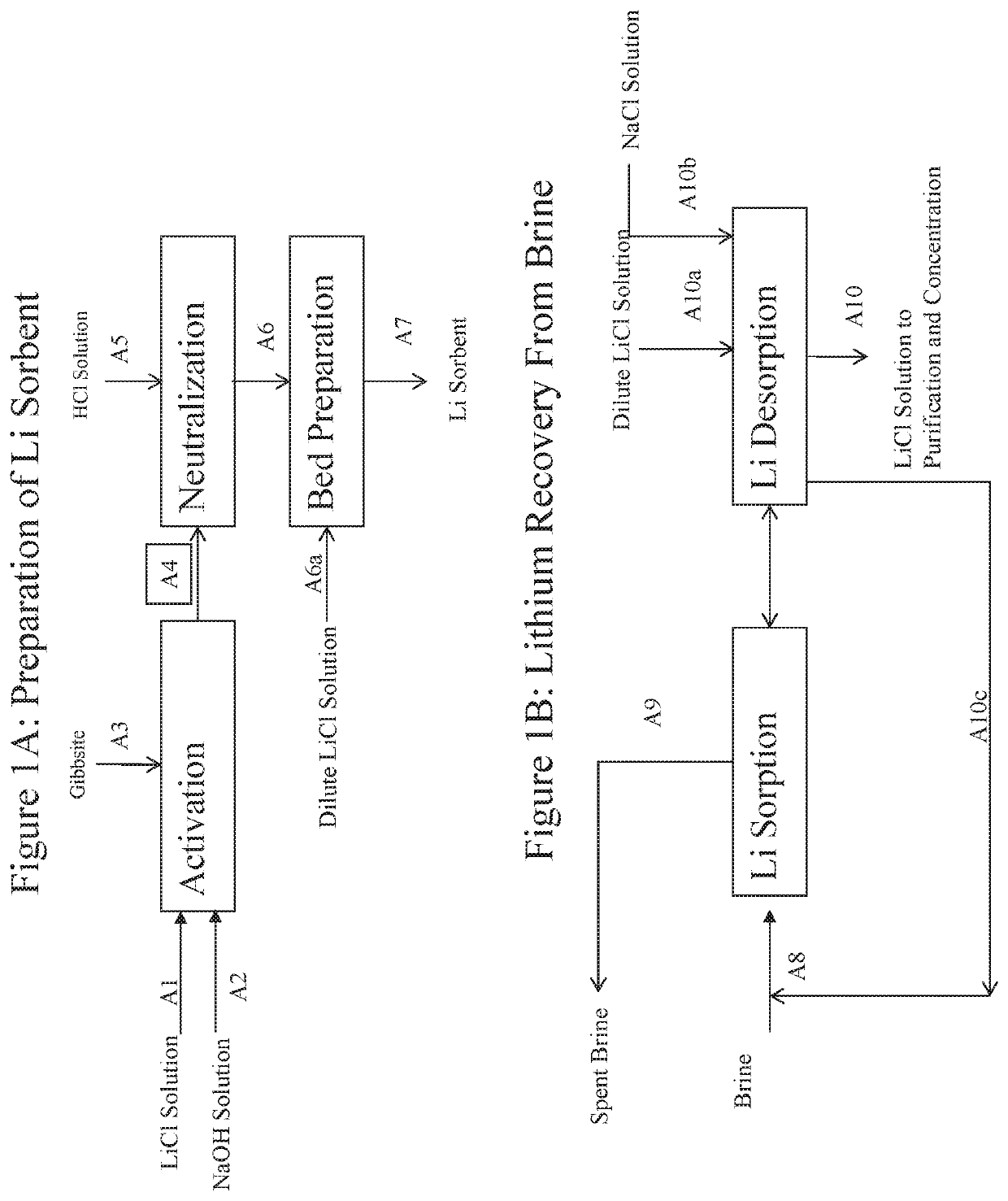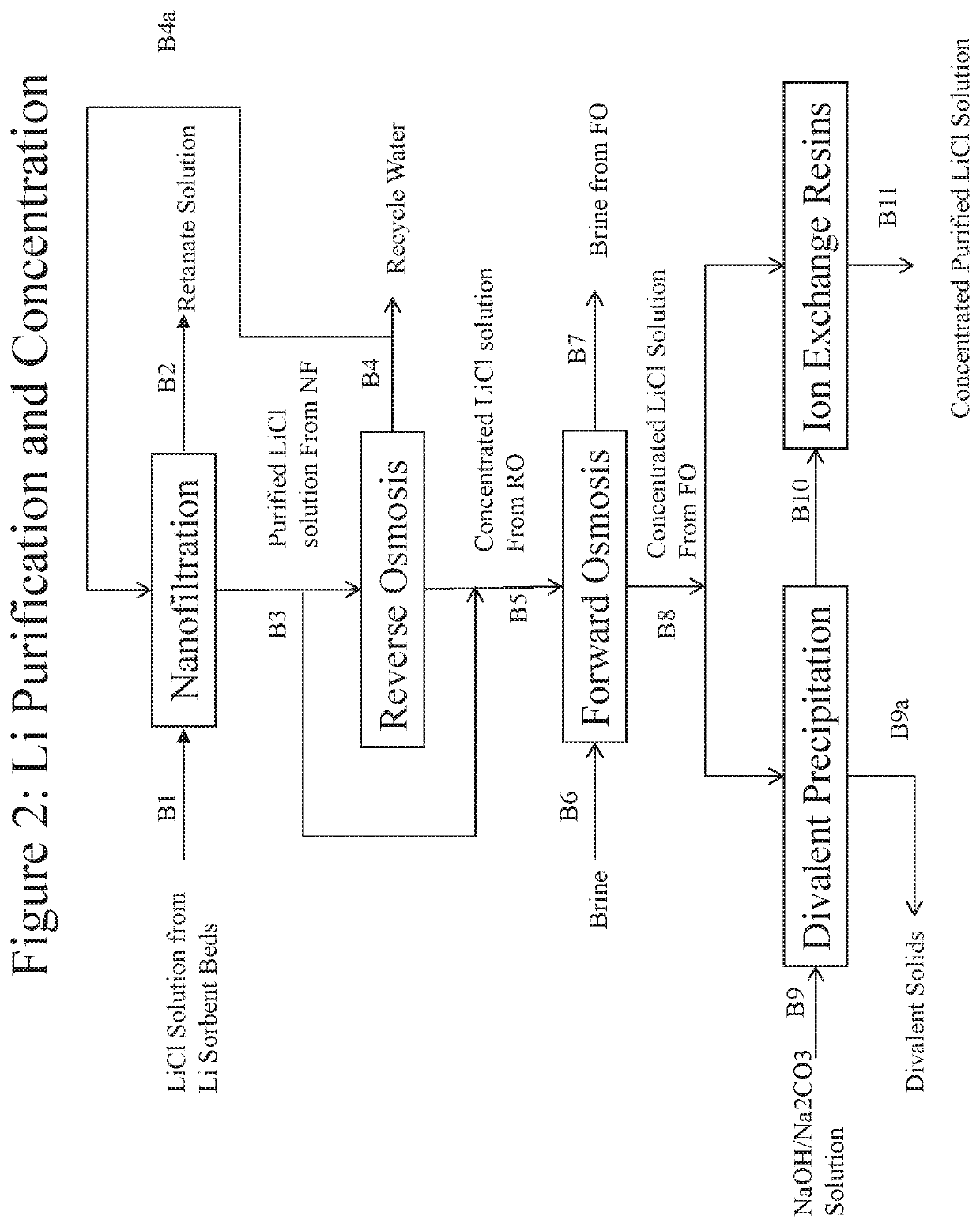Processes for recovering lithium values from lithium-containing brines
a technology of lithium-containing brines and recovery processes, which is applied in the direction of lithium halides, chemistry apparatus and processes, and other chemical processes, can solve the problems of greater performance loss, less desirable use of solution or brine of other suitable alkali metal salts, and unsatisfactory needs, etc., to achieve high purity, less cost, and more efficient
- Summary
- Abstract
- Description
- Claims
- Application Information
AI Technical Summary
Benefits of technology
Problems solved by technology
Method used
Image
Examples
example 1
Sorbent Activation
[0095]In this example, compressed Gibbsite is reacted with LiCl / caustic solution to produce a sorbent. The molar ratio of LiCl:NaOH:Gibbsite=0.5:0.4:1 and 8.0 wt % LiCl.
[0096]A 546 g (7.0 mol) portion of compressed Gibbsite (Compalox® ON / V-801) was reacted with 1855 g of a solution containing 8.0 wt % LiCl (3.5 mol) and 6.0 wt % NaOH (2.8 mol) in two plastic bottles placed in an oven at 70° C. After 24 hours, the combined content of the bottles was filtered. The filtrate contained 1710 ppm Li and the wet solids (818 g) contained 2.69% Li and 23.25 wt % Al (0.45 lithium to aluminum molar ratio).
example 2
[0097]This Example illustrates neutralization of (LiOH)a(LiCl)1-a.2Al(OH)3 to LiCl.2Al(OH)3 with hydrochloric acid in a column.
[0098]A 2″ diameter jacketed glass column was loaded with a 798 g portion (6.87 mol Al) of the wet solids from Example 1. Water was then fed to the bed upflow at 500 ml / min to remove any fine particles from the bed and until the effluent was clear. The effluent was filtered and 4.6 g and <0.6% of fine particles were recovered.
[0099]Water was then circulated upflow through the column at a constant rate of 600 ml / min, while maintaining the column at 70° C. A 20% solution of hydrochloric acid was then fed via a metering pump to the water recirculation pot to maintain a 3.5-5.0 pH value of the water being fed to the column. The neutralization was complete after about 36 hours, when the pH of the water effluent exiting the column dropped to 5.0. During the neutralization 3.6 g of fine particles were collected (about 0.4% of what was initiall...
example 3
[0100]This Example confirms the effective performance of the preferred sorbents described herein for recovering lithium values from brine. A 665.8 g portion (5.57 mol Al) of the solids from Example 2 was loaded into a 1″ diameter jacketed column for testing of the sorbent to recover LiCl value from brine.
[0101]The composition of the tested brine is given in Table 1.
[0102]To partially unload the lithium from the sorbent, to prepare the sorbent to recover LiCl from brine, 4.6 liter of water that contained 0.3% LiCl at 70° C. was upflowed through the sorbent at a constant flow rate of 60 g / min. The water was drained to the bed level by gravity. The water holdup in the bed was displaced with a void volume of brine by gravity.
[0103]For the first cycle, 8.8 liter of brine was upflowed through the column at 70° C. at a constant flow rate of 50 g / min. Recovery of lithium value from the feed brine in this cycle was 87%. The settled bed height was 43 inch. The brine...
PUM
| Property | Measurement | Unit |
|---|---|---|
| molar ratio | aaaaa | aaaaa |
| particle size | aaaaa | aaaaa |
| weight ratio | aaaaa | aaaaa |
Abstract
Description
Claims
Application Information
 Login to View More
Login to View More - R&D
- Intellectual Property
- Life Sciences
- Materials
- Tech Scout
- Unparalleled Data Quality
- Higher Quality Content
- 60% Fewer Hallucinations
Browse by: Latest US Patents, China's latest patents, Technical Efficacy Thesaurus, Application Domain, Technology Topic, Popular Technical Reports.
© 2025 PatSnap. All rights reserved.Legal|Privacy policy|Modern Slavery Act Transparency Statement|Sitemap|About US| Contact US: help@patsnap.com


